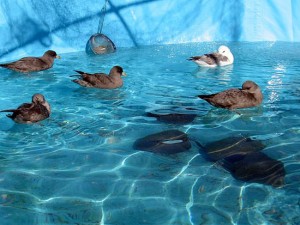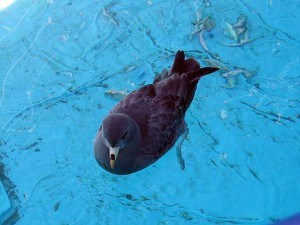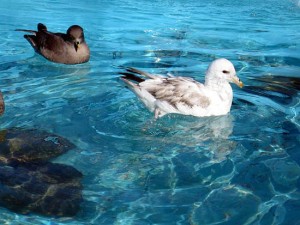This November several hundred seabirds washed ashore on Monterey Bay beaches. Unlike birds in San Francisco that were coated with bunker oil from the November 8 Cosco Busan oil spill, the birds in Monterey Bay lacked any evidence of oiling by petroleum products. Initially the most commonly affected seabirds were Western Grebes and Surf Scoters.
Scientists suspected a “mystery spill” had occurred, since some of the birds examined were covered with a white, waxy film. Subsequent tests conducted at the California Department of Fish and Game’s Water Pollution Control Lab using water samples and feathers pulled from dead birds determined the mysterious substance was neither fish, vegetable nor petroleum oil, but rather a surfactant protein. Surfactants act like a detergent and reduce the waterproofing ability of feathers. This protein has been associated with the recent algal bloom conditions in Monterey Bay (also called a red tide). Compromised feathers lose their insulating properties, leading to hypothermia and death.
On November 20 more than 250 Northern Fulmars washed up on southern Monterey Bay beaches. The Northern Fulmar, which resembles a seagull, is among the longest-lived birds with a life span of 30 years or more. Northern Fulmars breed in Alaska and Canada in the summer, then winter along the northern Atlantic and Pacific coasts. The rescued birds were very sick, lethargic and cold. Necropsies indicated the Northern Fulmars were very thin or emaciated and that most of them were young of the year. Most had pox-like lesions on the feet and in the esophagus, although not severely enough to be the likely cause of death. Some carcasses also will be tested for avian influenza. Sample feathers are also being tested for the surfactant protein associated with the algal bloom.
It is possible that the two incidents are related to one another, and the results of on-going laboratory tests should determine the strength of such links. For more information contact Jean de Marignac (831-647-4214).
Images below are of recovering seabirds taken by Beth Phillips of Moss Landing Marine Lab.


